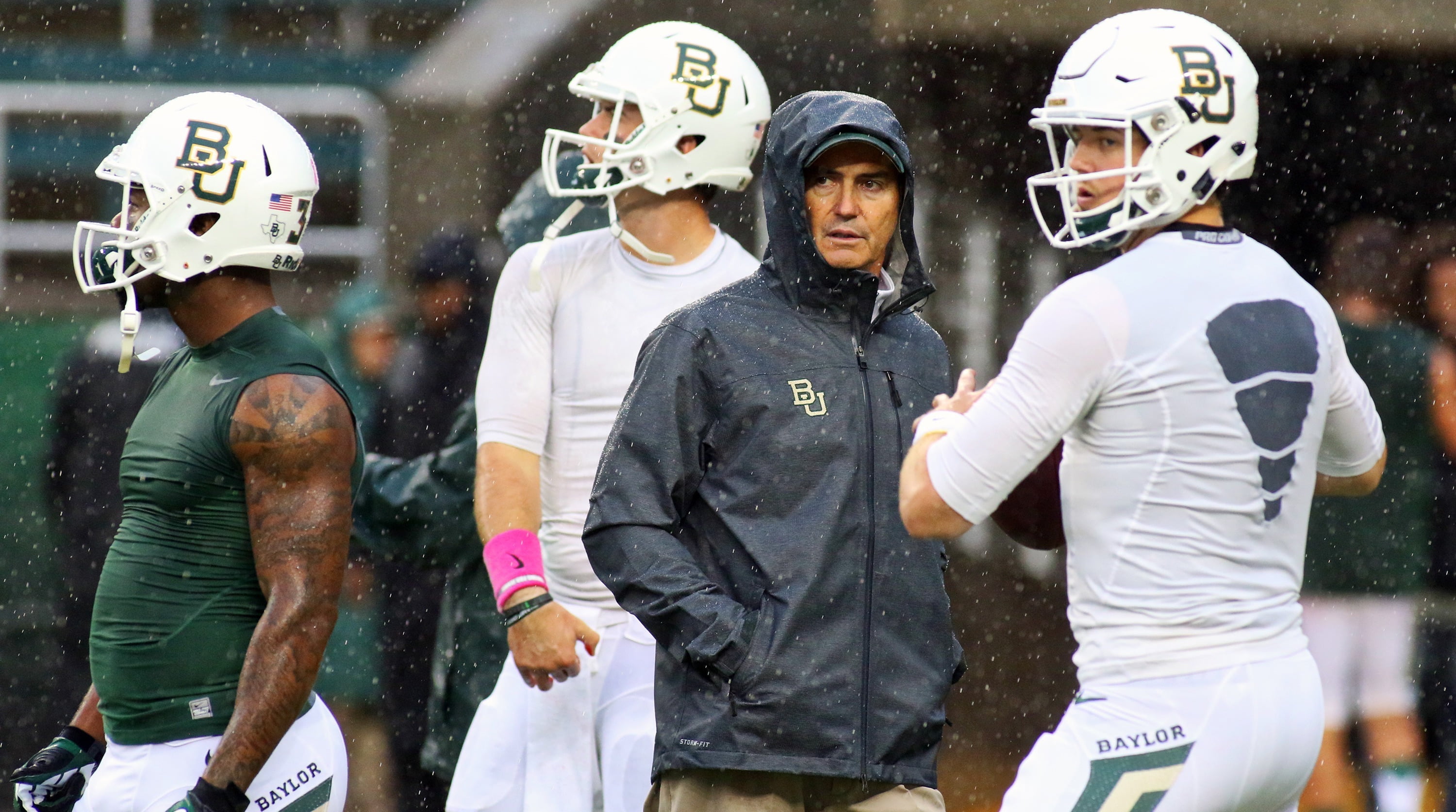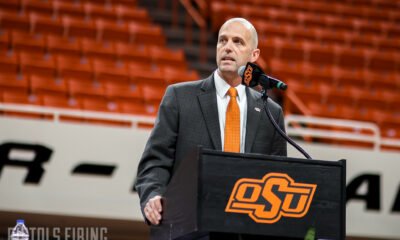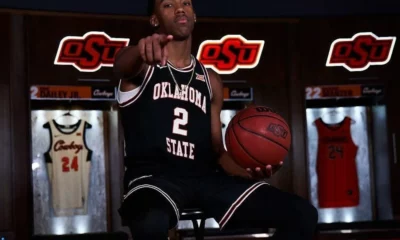Football
The Findings At Baylor Mean It Had No Choice But To Fire Art Briles

I think this Baylor stuff is what Sports Illustrated thought it was reporting about Oklahoma State a few years ago.
Forget everything I wrote here. Ok, not everything, but the part praising Baylor is now null and void after Baylor released its “finding of fact” from the Pepper Hamilton report on Thursday. Pepper Hamilton is the third party firm brought in to do an internal investigation on Baylor’s reported culture of assault and sexual assault.
What they found was not pretty.
And now it has become clear that Art Briles was fired on Thursday not because Baylor took the high road (although maybe they would have anyway) but because Baylor really had no choice but to fire Art Briles.
Consider the following six excerpts from the Pepper Hamilton report about victims of sexual assault at Baylor.
1. Pepper also found examples of actions by 2 University administrators that directly discouraged complainants from reporting or participating in student conduct processes, or that contributed to or accommodated a hostile environment.
In one instance, those actions constituted retaliation against a complainant for reporting sexual assault. In addition to broader University failings, Pepper found specific failings within both the football program and Athletics Department leadership, including a failure to identify and respond to a pattern of sexual violence by a football player, to take action in response to reports of a sexual assault by multiple football players, and to take action in response to a report of dating violence.
Pepper’s findings also reflect significant concerns about the tone and culture within Baylor’s football program as it relates to accountability for all forms of athlete misconduct.
What?!
I just don't understand how this happens, how people lose their way this badly – for something so relatively trivial https://t.co/AZ6kmAnhjb
— Travis Haney (@travhaney) May 26, 2016
2. Baylor failed to maintain effective oversight and supervision of the Athletics Department as it related to the effective implementation of Title IX. Leadership challenges and communications issues hindered enforcement of rules and policies, and created a cultural perception that football was above the rules. In addition to the issues related to student misconduct, the University and Athletics Department failed to take effective action in response to allegations involving misconduct by football staff.
Further, despite the fact that other departments repeatedly raised concerns that the Athletics Department’s response to student or employee misconduct was inadequate, Baylor administrators took insufficient steps to address the concerns.
Wow.
3. Baylor failed to take appropriate action to respond to reports of sexual assault and dating violence reportedly committed by football players. The choices made by football staff and athletics leadership, in some instances, posed a risk to campus safety and the integrity of the University.
In certain instances, including reports of a sexual assault by multiple football players, athletics and football personnel affirmatively chose not to report sexual violence and dating violence to an appropriate administrator outside of athletics.
In those instances, football coaches or staff met directly with a complainant and/or a parent of a complainant and did not report the misconduct. As a result, no action was taken to support complainants, fairly and impartially evaluate the conduct under Title IX, address identified cultural concerns within the football program, or protect campus safety once aware of a potential pattern of sexual violence by multiple football players.
Did not report the misconduct. This is like the Sandusky case but with adults, no?
4. In addition, some football coaches and staff took improper steps in response to disclosures of sexual assault or dating violence that precluded the University from fulfilling its legal obligations. Football staff conducted their own untrained internal inquiries, outside of policy, which improperly discredited complainants and denied them the right to a fair, impartial and informed investigation, interim measures or processes promised under University policy.
In some cases, internal steps gave the illusion of responsiveness to complainants but failed to provide a meaningful institutional response under Title IX. Further, because reports were not shared outside of athletics, the University missed critical opportunities to impose appropriate disciplinary action that would have removed offenders from campus and possibly precluded future acts of sexual violence against Baylor students.
In some instances, the football program dismissed players for unspecified team violations and assisted them in transferring to other schools. As a result, some football coaches and staff abdicated responsibilities under Title IX and Clery; to student welfare; to the health and safety of complainants; and to Baylor’s institutional values.
In other words, “we got this” even though you did not in fact got this.
5. In addition to the failures related to sexual assault and dating violence, individuals within the football program actively sought to maintain internal control over discipline for other forms of misconduct. Athletics personnel failed to recognize the conflict of interest in roles and risk to campus safety by insulating athletes from student conduct processes.
Football coaches and staff took affirmative steps to maintain internal control over discipline of players and to actively divert cases from the student conduct or criminal processes. In some cases, football coaches and staff had inappropriate involvement in disciplinary and criminal matters or engaged in improper conduct that reinforced an overall perception that football was above the rules, and that there was no culture of accountability for misconduct.
Once aware of a potential pattern of sexual violence, the University failed to take prompt and effective action to protect campus safety and protect future victims from harm. Further, Baylor failed to consider patterns, trends or climate-related concerns that would enable the University to take prompt and responsive action to individual and community concerns. Baylor failed to identify, eliminate, prevent or address a potential hostile environment in individual cases, and took insufficient steps with respect to both individual complainants and broader community remedies.
As one person pointed out to me, this likely happens other places with (presumably) non-sexual assault stuff … and it shouldn’t.
6. The football program failed to identify and maintain controls over known risks, and unreasonably accepted known risks. Leadership in football and the athletics department did not set the tone, establish a policy or practice for reporting and documenting significant misconduct. The lack of reporting expectations resulted in a lack of accountability for player misconduct and employee misconduct.
Further, no attempt was made to understand the root causes of behavior or steps necessary to prevent its recurrence. In addition, in one instance, in response to concerns about misconduct by football players that could contribute to a hostile environment, an academic program that required interaction with the football program improperly restricted educational opportunities for students, rather than take steps to eliminate a potential hostile environment.
Again, this is Baylor’s take on the findings of an organization (Pepper Hamilton) that apparently has a history of going easy on universities. So it’s likely not even as harsh as reality.
Somehow Briles remains the only person to be fired. President Ken Starr was reassigned to position of chancellor and AD Ian McCaw was put on probation.
So the real question now is not why Baylor fired Art Briles but how anyone on the football coaching staff (or the AD) there still has a job at all.

-

 Football2 days ago
Football2 days agoFour-Star Quarterback Adam Schobel Commits to Oklahoma State, Flips from Baylor
-

 Hoops3 days ago
Hoops3 days ago‘Keep Turning Over the Rocks’: Looking at the Portal Landscape as Lutz Looks to Solidify His First OSU Roster
-

 Hoops3 days ago
Hoops3 days agoFour-Star Signee Jeremiah Johnson Reaffirms Commitment to Oklahoma State after Coaching Change
-

 Daily Bullets2 days ago
Daily Bullets2 days agoDaily Bullets (Apr. 23): Pokes Land Four-Star Quarterback, Retain Talent from Mike Boynton Era






